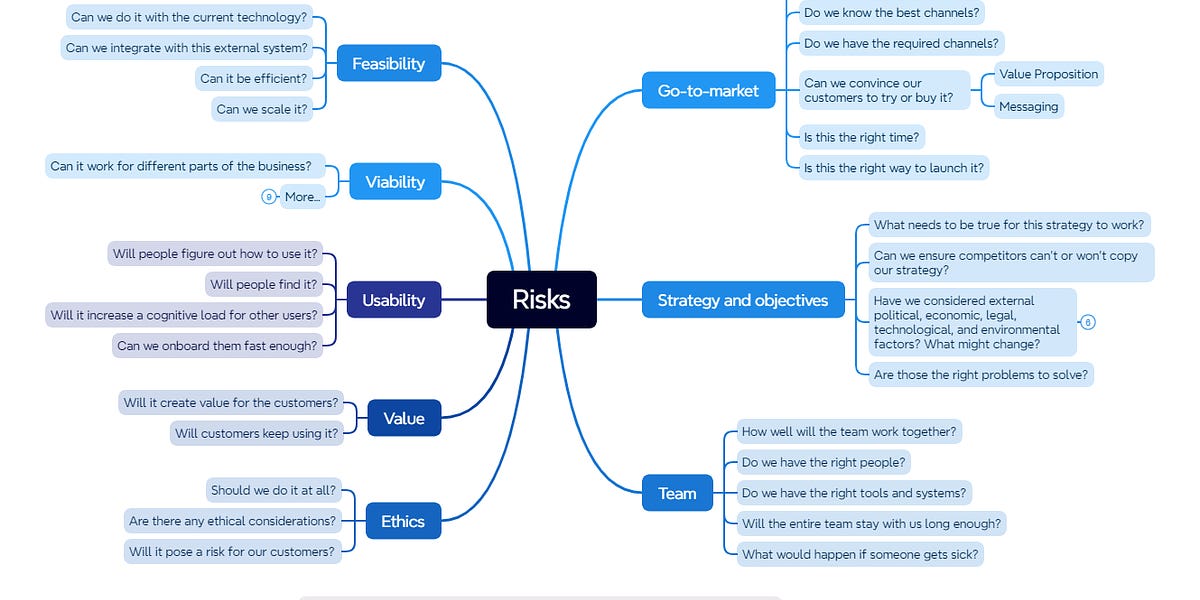# How to Manage Risks as a Product Manager

## Metadata
- Author: [[Paweł Huryn]]
- Full Title: How to Manage Risks as a Product Manager
- Category: #articles
- Summary: Product management involves managing risks, including both negative and positive risks. Risks in product management can be classified into different categories, such as go-to-market, strategy, and team-related risks. To deal with risks effectively, product managers should make informed decisions based on data, qualitative insights, and intuition.
- URL: https://www.productcompass.pm/p/how-to-manage-risks-as-a-product-manager?utm_source=post-email-title&publication_id=943157&post_id=145219584&utm_campaign=email-post-title&isFreemail=true&r=3mtnp9&triedRedirect=true&utm_medium=email
## Highlights
- Risks are unpredictable events that might impact [the outcomes](https://www.productcompass.pm/p/business-outcomes-vs-product-outcomes) we care about.
According to classical risk theory, there are two types of risks:
• **Negative risks**, for example, nobody wants to use a feature we built.
• **Positive risks** (or “opportunities”), for example, a new law is introduced, and our product helps customers become compliant. They are considered primarily by the product leaders. ([View Highlight](https://read.readwise.io/read/01hzfbe2kpq079n6b2n3e8jbab))
- There are many approaches to classifying risks. In [Continuous Product Discovery](https://www.productcompass.pm/p/what-exactly-is-product-discovery), we typically consider Value, Usability, Viability, and Feasibility risks, with Ethics either part of Viability or presented as a separate category:
[

](https://substackcdn.com/image/fetch/f_auto,q_auto:good,fl_progressive:steep/https%3A%2F%2Fsubstack-post-media.s3.amazonaws.com%2Fpublic%2Fimages%2Fef27af8e-18d4-478a-bc96-27acb02b09ee_623x632.png) ([View Highlight](https://read.readwise.io/read/01hzfbe8hce8aj3fa1vas6e0cs))
- • **Go-to-market.** Although it is often presented as part of the Viability risk, it deserves a separate category for new products. I will explain this later in the post.
[

](https://substackcdn.com/image/fetch/f_auto,q_auto:good,fl_progressive:steep/https%3A%2F%2Fsubstack-post-media.s3.amazonaws.com%2Fpublic%2Fimages%2Fc656b834-17ac-4064-ba58-9fd4a7fa8a33_561x243.png) ([View Highlight](https://read.readwise.io/read/01hzfbep7n5t8h1n2t224dxn9w))
- • **Strategy and objectives.** We usually ignore those risks when performing [Continuous Product Discovery](https://www.productcompass.pm/p/what-exactly-is-product-discovery). Later, I will explain how product leaders can mitigate those risks.
[

](https://substackcdn.com/image/fetch/f_auto,q_auto:good,fl_progressive:steep/https%3A%2F%2Fsubstack-post-media.s3.amazonaws.com%2Fpublic%2Fimages%2Fe611eb7c-ba74-4e72-9f10-38dd4d6a2c90_668x350.png) ([View Highlight](https://read.readwise.io/read/01hzfbes6z4prajrs4m89mzgff))
- • **Team.** Later, I will explain how product leaders can mitigate those risks.
[

](https://substackcdn.com/image/fetch/f_auto,q_auto:good,fl_progressive:steep/https%3A%2F%2Fsubstack-post-media.s3.amazonaws.com%2Fpublic%2Fimages%2F91235321-2981-404b-8402-fe6e870d1e89_451x185.png) ([View Highlight](https://read.readwise.io/read/01hzfbew6t5db8y500m41tn7fk))
- In product management, you can’t eliminate risks completely. You also can’t ensure that positive risks (opportunities) are realized.
> *“100% predictability = 0% innovation”* - Henrik Kniberg ([View Highlight](https://read.readwise.io/read/01hzfbf88jfq2597v3gpfj0rth))
- The most common ways of dealing with risks:
• **Negative risks:**
• ==Mitigate the risk==, for example, by conducting an experiment to test an assumption.
• ==Accept the risk==, for example, by continuing with the implementation and testing the idea in production.
• ==Avoid the risk==. For example, do not implement an idea if the risk is too high and can’t be easily mitigated.
• **Positive risks**
• Enhance the probability, for example, by assigning the same problem to multiple teams.
• Accept (do nothing). ([View Highlight](https://read.readwise.io/read/01hzfbfdjxk6dggwegxanpvcvz))
- Your decisions should be informed (not driven) by:
• **Data** (quantitative insights, e.g., product and data analytics, experiment results).
• **Qualitative insights** (e.g., customer interviews, stakeholders, social listening, changes in the market, new technologies).
• **Intuition** (aka “product sense”), which results from experience and immersing yourself in the market and the business context. As Marty Cagan [said](https://www.svpg.com/product-sense-demystified/), *“I argue that strong product sense is better described as deep product knowledge, and is the result of truly immersing yourself into a specific product space.”*
[

](https://substackcdn.com/image/fetch/f_auto,q_auto:good,fl_progressive:steep/https%3A%2F%2Fsubstack-post-media.s3.amazonaws.com%2Fpublic%2Fimages%2F9b8a469d-2bfe-4340-ac54-72afdf8c51ec_426x388.png) ([View Highlight](https://read.readwise.io/read/01hzfbfjapwnr8zayrr7qpqfs9))
- A great way to identify assumptions related to Value, Usability, and Feasibility is by using the [User Story Map (template](https://docs.google.com/presentation/d/1axTmdT7hD6t7t5gqKbg0Lzo7j6xMD6ZB/edit?rtpof=true&sd=true)). ([View Highlight](https://read.readwise.io/read/01hzfbk4q2ye58kp1ndzhf3nrx))
- • Combine the top product discovery techniques: Opportunity Solution Tree, Opportunity Score, and Strategyzer cards. ([View Highlight](https://read.readwise.io/read/01hzfbm3qgftbcm7fk8htg0psa))
- You can’t eliminate risks completely. Even Continuous Product Discovery mitigates key risks but doesn’t eliminate them entirely.
> The ultimate test is users interacting with your product in the real world, using their own data.
>
> That’s why you need to perform small, frequent releases and use telemetry to understand how people use your product.
This aligns well with Marty Cagan’s [Product Delivery Principles](https://www.productcompass.pm/i/142664566/four-product-delivery-principles):
• Principle 13: [Small, Frequent, Uncoupled Releases](https://www.productcompass.pm/i/142664566/principle-small-frequent-uncoupled-releases)
• Principle 14: [Instrumentation](https://www.productcompass.pm/i/142664566/principle-instrumentation)
• Principle 16: [Deployment Infrastructure](https://www.productcompass.pm/i/142664566/principle-deployment-infrastructure)
[

](https://substackcdn.com/image/fetch/f_auto,q_auto:good,fl_progressive:steep/https%3A%2F%2Fsubstack-post-media.s3.amazonaws.com%2Fpublic%2Fimages%2Fe94a6820-c4d3-4a76-a365-4251578b972f_627x140.png) ([View Highlight](https://read.readwise.io/read/01hzfbja4zkb674h23hwn9d1k4))
- When product teams perform continuous product discovery, they usually focus on well-known “Value, Usability, Viability, and Feasibility.”
But, depending on the context, there are three other important risk areas to consider:
• Go-to-market (new products),
• Strategy and Objectives (product leaders),
• Teams (product leaders). ([View Highlight](https://read.readwise.io/read/01hzfbhpk355v7h73e7fhsz9w1))